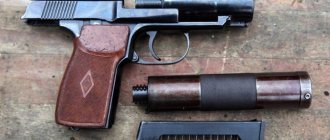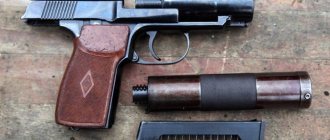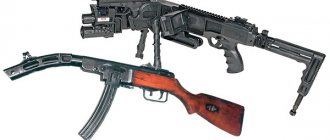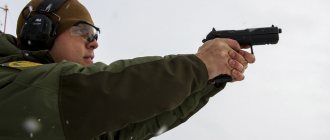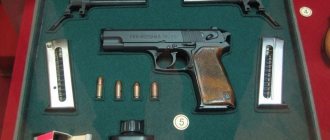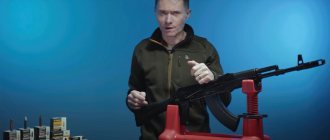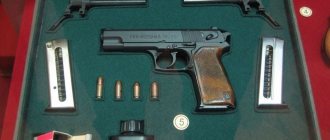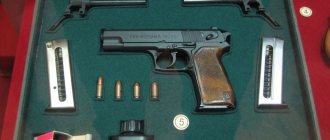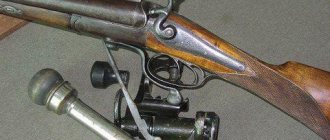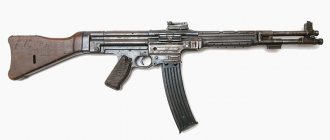Variability
In KRISS everything is different from conventional weapons. In the polymer upper receiver (upper), made integral with the pistol grip, there is a trigger with an “inverted” trigger and a safety block that blocks the trigger. In the upper part of the receiver, a 332 mm long aluminum Picatinny rail is installed on the dovetail - the entire length of the receiver. The original KRISS has a folding stock adapter attached to the rear of the receiver. In our version, after undergoing technological intervention, it turned into an adapter for a non-folding telescopic stock. The telescopic stock itself with six positions for adjusting the length resembles the Magpul CTR - however, judging by the markings, it was manufactured by Defiance (the Defiance company, previously known for its silencers, is currently, along with Sphinx, a Swiss manufacturer of pistols of the same name, part of the KRISS corporation USA). Based on some signs, it can be assumed that the upper receiver for the KRISS was not only developed, but also produced by Magpul - in any case, its logo is printed on the detachable cover of the pistol grip, which is part of the receiver.
Incomplete disassembly
The KRISS barrel is made of 4140 steel and has six right-hand rifling at 1:10” (254 mm) pitch. Barrel protective coating is a type of carbonitriding. The barrel and the entire mechanism are located in the lower steel receiver (lower), which has polymer linings and light-alloy inserts; in its front part there is an inclined magazine shaft. The release button is located on the front left. On the left side of the lever there is a bolt stop button, which also serves as an indicator of the presence of a cartridge in the chamber. Above it is a folding cocking handle that is motionless during firing. The bow and upper are secured by three pins, the fourth holds the bolt frame/return mechanism unit in place in the lower body.
The KRISS Vector SMG is in service with special units of a number of US police departments, including the SWAT team of the Buckeye Police Department, Arizona. In 2015, the KRISS Vector SMG was adopted by the Philippine National Police; its testing continues in the special forces of Saudi Arabia, Thailand, India, as well as in the British SAS
Changing the caliber of a weapon is a matter of a few seconds: you manually pull out three pins, disconnect the lower receiver, install a new one designed for a different caliber, and secure it with pins. In terms of speed of caliber changes, KRISS is undoubtedly a champion. You may ask: what can this be useful for? For now, we admit, there is nothing special for it - but it is likely that in the future bowmen in different calibers, equipped with barrels of various lengths, will appear on sale.
Differences from combat
The 9x21 IMI caliber version was introduced in 2015 specifically for the markets of Italy and Ukraine. The buttstock is non-folding, in the SBR version it is fixed in the unfolded position, the barrel length is 203 mm instead of 140 or 170 mm for the SMG, the absence of automatic fire - that’s, in fact, all the differences. The magazines supplied with the carbine have a capacity of 10 rounds, but any magazine from Glock 17/34 pistols can be used. Long or short?
Hunting carbine KRISS Vector SBR: total weight of the weapon with Magpul MBUS sights - 3.25 kg (without magazine), total length - 805 mm
The debate about the advisability of using a long barrel in a weapon chambered for a pistol cartridge has no end. One opinion says that a supposedly long barrel allows the bullet to reach maximum speed, and this, in turn, increases the range of effective use. We decided to check how real this influence is. So, four carbines (a set of SBR with a 203 mm barrel and a CRB with a 406 mm barrel in 9x21 and .45 ACP calibers), one type of cartridge each for 9x21 and .45 ACP. The results surprised us: in the 9x21 caliber, doubling the barrel length gives an increase in initial speed of only 12 m/s, that is, by 3.2% (385 m/s versus 373 m/s). In .45 ACP the situation is identical - the same 3.2% (277 m/s versus 270 m/s)!
Based on the results, the question “does increasing barrel length affect muzzle velocity when using a pistol cartridge?” We boldly answer - “practically no”! Fast-burning pistol powder manages to burn completely in a short barrel - and in a long barrel, although the bullet continues to be accelerated by gas pressure, it is slowed down by friction against the surface of the barrel bore.
KRISS Vector CRB hunting carbine: total weapon weight with Magpul MBUS sighting devices - 3.765 kg (without magazine and Shield SIS collimator)
However, the answer to the question “is the use of a long barrel in a weapon chambered for a pistol cartridge justified?” lies in several planes. The length of the sighting line is the same on the two versions, so there is no advantage to either one. From the point of view of convenience when shooting, the long-barreled version wins, since it allows you to more comfortably place your holding hand. Also, the long-barreled version has no danger of getting burned on a hot barrel. By the way, the CRB barrel casing does not heat up so quickly and provides a comfortable hold even after two dozen shots in a row. In addition, despite the fact that this is a casing and not a sound moderator, the sound of the shot is much quieter. So, in reality, the choice between long and short is a matter of taste.
Shooting modes
KRISS Vector allows you to fire in three modes: single, 2-round burst and automatic continuous. The fire selector is separated from the fuse. For some this will cause inconvenience, for others it will be an opportunity to set the fire mode to the desired one in advance. Both controls are duplicated on both sides, making the KRISS Vector convenient for left- and right-handers.
Design
The author of the original design was Renault Kerbra. Kriss Super V uses a semi-blowback automatic. The automation system works due to a special counterweight insert moving in an almost vertical plane behind the magazine neck. Special protrusions of the bolt rest against the inclined grooves of the liner, as a result of which, during a shot, the recoil of the bolt is slowed down by the force of friction against the liner, which tends to move downwards. The handle is located quite high relative to the axis of the barrel, the top of the butt plate is on the same axis with the barrel, which allows you to combine the shoulder stop point and the recoil impulse vector. Coupled with a semi-free bolt, all this makes it possible to achieve fairly smooth, controlled recoil and an almost complete absence of barrel bounce, which is only aggravated by the high rate of fire.
karelmilitary
Cool! Especially the emphasis of the shooting hand and the butt along the recoil axis! Nice machine. It’s interesting, if you roll it in the dirt, how quickly it can be disassembled for cleaning. And can it be understood without tools?
Edited at 2015-07-13 05:38 am (UTC)
- Reply
- Thread
- Reply
- Parent
- Thread
- Reply
- Parent
- Thread
- Reply
- Parent
- Thread
Who knows?
- Reply
- Parent
- Thread
Options
At the moment, there are two main variants of the submachine gun: the “combat” version of the Vector SMG
, intended for law enforcement agencies, law enforcement agencies and the military with a short (140 mm) barrel and automatic firing options, and the civilian version
Vector CRB/SO
, with a barrel extended to 406 mm (according to American law, civilian long-barreled weapons must have a barrel length of at least 16 inches, otherwise it is considered a short-barreled weapon, which is much more difficult to obtain a license for in some states), on top of which a simulated silencer is placed for greater aesthetics, and can only be fired in semi-automatic mode.
For those places where legislation allows it, a civilian version of the Vector SBR/SO
with a short barrel is sold. All versions of the Kriss Super V have special guides - a Picatinny rail, made on top of the receiver and under the barrel, thanks to which it can be equipped with any types of mechanical, collimator and optical sights, flashlights, laser designators and additional front handles. In the first generation of the submachine gun, tactical flashlights can be installed in an empty niche above the barrel. The submachine gun uses 17-round magazines similar to those used in the Glock 21, as well as extended magazines that can hold 30 rounds.
Kriss Vector super v
- Please log in to reply.
VG_13 #1 Posted December 10, 2022 — 23:54
The weapon is a lightweight submachine gun with upward recoil reduced by nearly 95% and backward recoil by 60%.
The shooter can hit targets very, very effectively, and with great speed. Will be very useful for the medic class.
Basic data of the Kriss Super V software: - caliber 0.45 ACP and 0.40 S&W; — height 17.5 centimeters; — length 62 cm; — weight 2 kilograms; — rate of fire adjustable from 800 to 1500 rpm. — sighting range 45 meters.
Additional information The cost of one PP is 1500-2000 dollars, depending on the version. An attempt to create a mass-produced and inexpensive submachine gun did not work out. The US military department did not see any distinctive features in the Kriss Super V SMG. All analogues are inferior to it in many characteristics. But having adopted it as the main personal weapon, it could well have become widespread like the Soviet “Kalashnikov”, because, in fact, they have a lot in common - increased reliability, unpretentiousness and high lethality.
Post edited by VG_13: December 11, 2022 - 0:47
- Top
VadyaraMur #2 Posted December 10, 2022 — 11:57 pm
VG_13 (December 10, 2022 - 23:54) wrote:
It will be very useful for the medic class.
I am already here, famine, pestilence and war will soon approach us.
[Removed due to vegetable complaints]
- Top
VG_13 #3 Posted December 11, 2022 — 0:10
Supreme_Reaper (December 10, 2022 - 23:57) wrote:
- Top
VG_13 #4 Posted December 11, 2022 — 0:13
Supreme_Reaper (December 10, 2022 - 23:57) wrote:
- Top
Chanderlin #5 Posted December 11, 2022 - 2:51 am
- Top
venom0822 #6 Posted December 11, 2022 - 9:13 am
I noticed that the doctor had what appeared to be a similar weapon (FSB).
Actually, it was actually used by units, unlike Criss Victor. It was created as a prototype. I don’t know about mass production. But it never got into service.
Compare distribution with Kalashnikov? Which in Arab countries and hot conflict countries costs $800 versus 1500 (the cheapest) IMHO - no one will need such a PP for which you won’t even find cartridges.
For the good old AK, you want 5.56, you want 7.62, even wood. The reliability here has been proven over the years. The criss vector showed itself only in “lamp” tests. Put it in field testing and it's all sad.
- Top
CTAKAHl34l #7 Posted December 11, 2022 — 10:33
- Top
VG_13 #8 Posted December 11, 2022 — 10:56
venom0822 (December 11, 2022 - 9:13 am) wrote:
I noticed that the doctor seemed to have a similar weapon (FSB).
Actually, it was actually used by units, unlike Criss Victor. It was created as a prototype. I don’t know about mass production. But it never got into service.
Compare distribution with Kalashnikov? Which in Arab countries and hot conflict countries costs $800 versus 1500 (the cheapest) IMHO - no one will need such a PP for which you won’t even find cartridges.
For the good old AK, you want 5.56, you want 7.62, even wood. The reliability here has been proven over the years. The criss vector showed itself only in “lamp” tests. Put it in field testing and it's all sad.
We are not arming the army here, but discussing weapons for special forces.
In the 1950s, production licenses for Kalashnikov assault rifles (AKs) were transferred by the USSR to eighteen countries, mostly Warsaw Pact allies. At the same time, eleven more states began producing AKs without a license. The number of countries in which AKs were produced without a license in small batches, much less handicraft, cannot be counted. To date, according to Rosoboronexport, the licenses of all states that previously received them have already expired, however, production continues, since all possible patent protection periods for the original AK (created in 1949) and AKM (1959) have already expired year of creation). The production of AK clones is deployed in Asia, Africa, the Middle East, Europe and the USA, both under a license from Izhmash OJSC and without it. According to very rough estimates, there are from 70 to 105 million copies of various modifications of Kalashnikov assault rifles in the world. (https://qps.ru/KthDq)
The main task of this weapon was to achieve the highest possible accuracy of burst fire using .45 ACP cartridges (https://qps.ru/51DtB), which have a high stopping effect of the bullet, but at the same time minimize the dimensions and total weight of the submachine gun.
Post edited by VG_13: 11 December 2022 - 11:00
- Top
Otto_fon_Gamer #9 Posted December 11, 2022 — 11:43
- Top
venom0822 #10 Posted December 11, 2022 - 11:50
VG_13 (December 11, 2022 - 10:56 am) wrote:
We are not arming the army here, but are discussing weapons for special forces.
In the 1950s, production licenses for Kalashnikov assault rifles (AKs) were transferred by the USSR to eighteen countries, mostly Warsaw Pact allies. At the same time, eleven more states began producing AKs without a license. The number of countries in which AKs were produced without a license in small batches, much less handicraft, cannot be counted. To date, according to Rosoboronexport, the licenses of all states that previously received them have already expired, however, production continues, since all possible patent protection periods for the original AK (created in 1949) and AKM (1959) have already expired year of creation). The production of AK clones is deployed in Asia, Africa, the Middle East, Europe and the USA, both under a license from Izhmash OJSC and without it. According to very rough estimates, there are from 70 to 105 million copies of various modifications of Kalashnikov assault rifles in the world. (https://qps.ru/KthDq)
The main task of this weapon was to achieve the highest possible accuracy of burst fire using .45 ACP cartridges (https://qps.ru/51DtB), which have a high stopping effect of the bullet, but at the same time minimize the dimensions and total weight of the submachine gun.
Minuses
If the grip of the left hand holding the weapon is incorrect, the carbine involuntarily becomes restrained on the slide stop by the part of the palm between the base of the thumb and the muscles of the wrist - and during tempo shooting this is depressing. When using a left-sided grip or transferring a weapon from a right-sided to a left-sided grip, which may be necessary when passing through doors during an assault or clearing a room, the fingers of the right hand fall just on the magazine release button - and the magazine treacherously falls out. This can be treated either by grip training or by installing an additional front handle on the Picatinny rail. When the pistol grip is deeply seated in the palm, the thumb of the right hand may touch the safety lever - which will also lead to a stop in shooting. Only training will help you cope with this.
pros
It's really fun to shoot! KRISS practically does not throw up, and the recoil is transmitted by a weak push to the shoulder. Even if this is not particularly critical in a semi-automatic, I have, although not very much, experience shooting from an automatic KRISS SMG in .45 ACP - at a distance of 10 m, the entire optional 30-round magazine was placed in one burst into a circle with a diameter of 20 cm.
KRISS is compact - during our test, we shot five rounds of SBR and CRB carbines in 9x21 caliber equipped with a Nightforce SHV 4-14x56 optical sight at a distance of 50 m from a sitting position with a rest. The best groups of five holes had a diameter of 6 cm, the worst - no more than 12 cm. This is a good indicator, but if you are a supporter of truly outstanding accuracy, then we do not recommend shooting further than 25 m - at this distance our groups of five shots had a diameter of 2. 5-3.5 cm. Triggering force of a single-stage trigger is 2.5 kg. It is easy to mount accessories on the KRISS Vector - from optical/red dot sights to a variety of handles, target designators and flashlights. KRISS uses cheap and easily accessible stores. And finally, even the most civil bespectacled man with a potbelly, holding a KRISS Vector in his hands, looks like passion as tactically!
karelmilitary
Cool! Especially the emphasis of the shooting hand and the butt along the recoil axis! Nice machine. It’s interesting, if you roll it in the dirt, how quickly it can be disassembled for cleaning. And can it be understood without tools?
Edited at 2015-07-13 05:38 am (UTC)
- Reply
- Thread
- Reply
- Parent
- Thread
- Reply
- Parent
- Thread
- Reply
- Parent
- Thread
Who knows?
- Reply
- Parent
- Thread
Re: Who knows?
- Reply
- Parent
- Thread
What is understood is clear. “What one person assembled, another can always break it” (c) The question is speed and the need for special tools.
Here I found it in the open: It should be added that although KRISS Super was developed by a private company, it was done in collaboration with the US Army ARDEC Picatinny Arsenal, an army research center. The goal of this development was to obtain a modern compact 45-caliber submachine gun with high fire accuracy. Judging by the cartridge used, this submachine gun was planned for special operations, since the conventional army and the Marine Corps switched to the 9x19 Luger cartridge back in the mid-80s, and the classic American .45 ASP cartridge was retained only by the Marine Expeditionary Unit "MEU:SOC" ", and part of the units of the joint Special Operations center. The official KRISS ARMS website is proud to announce that the Criss Vector is the fruit of five years of development together with the US Army. That's just it. the site does not at all focus on the fact that the Criss Vector did not enter service with the US Army. And here, from the media image from movies and computer toys, we move on to the boring realities of life.
According to the manufacturer, the patented Criss Vector recoil reduction mechanism, compared to classic submachine guns of the same caliber, such as the German Hekler und Koch UMP .45, reduces recoil by 60%. This is confirmed by a test on a dynamic recoil meter, which was rested on the butt plate of both samples, in single-fire mode. All this is grandiose, if not for one nuance: In the hands of shooters, even very experienced ones, when firing in a burst, the recoil jerks the Criss Vector so that all cartridges except the first one fly into milk at a distance of a couple of tens of meters. This is due to the fact that due to the light shutter, Chris Vector has an absolutely wild rate of fire - 1200 rounds per minute. (For example, the “H-K YMP” already mentioned above has a rate of fire of 600 m). Criss Vector madly butts into the shooter's shoulder, the cartridges fly past the target, the magazine is empty literally in a split second. You can, of course, turn on the firing mode with a cutoff of two - this will protect you from instantly emptying the magazine, but it does not save you from wild scattering of hits.
What about the super recoil damping mechanism? - The reader will ask. Well. Of course he redistributes something there, yes. When shooting with single fire, each time after a shot the shooter feels, instead of a toss up, a noticeable downward dive (which, in general, is also not very healthy), and when shooting in automatic mode, the barrel indomitably drags upward - such are innovative technologies.
Edited at 2015-07-14 05:31 am (UTC)
Second generation
The second generation of KRISS available to us - CRB/SBR Gen 2 - provides the ability to change the caliber by replacing the lower receiver, the angle of movement of the safety key has been changed from 120° to 45°, a telescopic butt and a technological hole for installing a Surefire flashlight are provided. The lower receiver is now treated with Ceracote. The carbine comes in a plastic case and is equipped with folding iron sights made by Magpul. Additionally, you can purchase side Picatinny rails and a hand rest stop mounted on the forend - this is relevant for the short version.
Forerunner
1954 world champion Pyotr Konstantinovich Sheptarsky worked on the problem of improving results when performing the MP-8 exercise (small-caliber rapid-fire pistol). In this exercise, five identical targets briefly appear in front of the shooter at a range of 25 m, each of which must be hit with one shot.
Controls: folding cocking handle, bolt release button/cartridge presence indicator, magazine release button
The MP-8 exercise program consists of 60 shots and is performed in two stages, each of which includes six qualifying series of five shots, with eight seconds allocated for two series, six seconds for two more, and six seconds for the last two. four seconds each. During Sheptarsky’s time, the MP-8 exercise was performed using .22 Short caliber pistols - however, despite the extreme low-impulse nature of this cartridge, fractions of a second were still spent on compensating for the barrel toss when transferring fire. It is well known that the tossing of a pistol during recoil is caused by the axis of the barrel exceeding the center of mass of the pistol and the hand. What if you lower the barrel to the middle of the wrist joint - to the level of the middle finger? The result lived up to expectations - the recoil impulse was now directed through the wrist joint without turning the hand, the knocking effect was practically reduced to zero, and the shooter felt only a push in the shoulder.
Incomplete disassembly: a closed bolt is visible in the lower, and a pulled trigger in the upper
The transfer of fire was made easier because the aiming line remained aimed at the target. Sheptarsky made a prototype based on the Margolin pistol, and a whole team at TsKIB was involved in finalizing the model. The official name of the pistol is MTs-3 “Record”, but among athletes it became known as the “Sheptarsky frame”.
In 1955, E. Cherkasov became the European champion with a new pistol. In 1956 in Hungary, at the championship of friendly armies, V. Nasonov set an all-Union record of 592 points, two months later E. Khaidurov repeated it. But the victorious march of the “frame” was short-lived: in 1956, the International Shooting Union introduced a new requirement into the rules of shooting competitions, according to which the bore of the weapon should be located no lower than the membrane between the thumb and index finger of the shooter’s hand - and this was the end of the official career of the MC- 3.
How it works?
The KRISS Super V uses a patent from the French designer Renaud Kerbrat. Previously working for FN Herstal, Kerbra created the concept while already an employee of the Swiss company Gamma AVG, from which TDI later grew. He named his brainchild Kerbra in honor of the Indonesian traditional dagger “keris” (or “kris”) with a characteristic wavy blade shape. Thanks to the shape of the handle and special recesses in the blade, the kris became a kind of extension of the index finger.
Kerbra used a semi-blowback system with the recoil-driven bolt group directed downward at a high angle.
Shutter and frame with return mechanism
The KRISS Super V bolt is small - its weight is only 100 g. Two side protrusions in its front part slide along guide grooves in the receiver, the third - the top one - is needed to interact with the cocking handle. The shank of the spring-loaded striker protrudes from the recess at the rear of the bolt. When fired, the bolt, under the influence of gas pressure at the bottom of the cartridge case, begins to move backward, interacting with the hammer and cocking it. The bolt shank interacts with an inclined groove in the bolt carrier, causing it to move downward. Moreover, due to the angle of inclination of this groove, which is 45°, the shutter travels almost half the distance than a massive frame - that is, the opening of the shutter slows down. A Sakov-type extractor removes the cartridge case, and it is deflected by a steel ejector. Moving down the guide until the polymer damper touches the steel base, the bolt carrier compresses the return spring. Due to this movement, the recoil vector is also partially redirected downward, compensating for the toss of the barrel. According to the designer's idea, the recoil and toss impulses of the weapon when fired should compensate each other. During the reverse movement, under the force of the spring, the bolt picks up the cartridge from the magazine and sends it into the chamber.
The patent description itself states that the main feature of the design is the redirection of the recoil vector (re-vectoring) downward, which compensates for the toss. In addition to this, the barrel of the Super V is lowered and is on the same axis with the middle finger of the shooter's hand. As a result, when firing from a fully automatic KRISS Super V, the recoil and toss of the weapon are negligible, which ensures high accuracy of automatic fire and excellent controllability of the weapon during shooting. These characteristics are fully preserved in the semi-automatic version - KRISS Vector.
Kriss Vector super v
- Please log in to reply.
VG_13 #1 Posted December 10, 2022 — 23:54
The weapon is a lightweight submachine gun with upward recoil reduced by nearly 95% and backward recoil by 60%. The shooter can hit targets very, very effectively, and with great speed.
Will be very useful for the medic class.
Basic data of the Kriss Super V software: - caliber 0.45 ACP and 0.40 S&W; — height 17.5 centimeters; — length 62 cm; — weight 2 kilograms; — rate of fire adjustable from 800 to 1500 rpm. — sighting range 45 meters.
Additional information The cost of one PP is 1500-2000 dollars, depending on the version. An attempt to create a mass-produced and inexpensive submachine gun did not work out. The US military department did not see any distinctive features in the Kriss Super V SMG. All analogues are inferior to it in many characteristics. But having adopted it as the main personal weapon, it could well have become widespread like the Soviet “Kalashnikov”, because, in fact, they have a lot in common - increased reliability, unpretentiousness and high lethality.
Post edited by VG_13: December 11, 2022 - 0:47
- Top
VadyaraMur #2 Posted December 10, 2022 — 11:57 pm
VG_13 (December 10, 2022 - 23:54) wrote:
It will be very useful for the medic class.
I am already here, famine, pestilence and war will soon approach us.
[Removed due to vegetable complaints]
- Top
VG_13 #3 Posted December 11, 2022 — 0:10
Supreme_Reaper (December 10, 2022 - 23:57) wrote:
- Top
VG_13 #4 Posted December 11, 2022 — 0:13
Supreme_Reaper (December 10, 2022 - 23:57) wrote:
- Top
Chanderlin #5 Posted December 11, 2022 - 2:51 am
- Top
venom0822 #6 Posted December 11, 2022 - 9:13 am
I noticed that the doctor had what appeared to be a similar weapon (FSB).
Actually, it was actually used by units, unlike Criss Victor. It was created as a prototype. I don’t know about mass production. But it never got into service.
Compare distribution with Kalashnikov? Which in Arab countries and hot conflict countries costs $800 versus 1500 (the cheapest) IMHO - no one will need such a PP for which you won’t even find cartridges.
For the good old AK, you want 5.56, you want 7.62, even wood. The reliability here has been proven over the years. The criss vector showed itself only in “lamp” tests. Put it in field testing and it's all sad.
- Top
CTAKAHl34l #7 Posted December 11, 2022 — 10:33
- Top
VG_13 #8 Posted December 11, 2022 — 10:56
venom0822 (December 11, 2022 - 9:13 am) wrote:
I noticed that the doctor seemed to have a similar weapon (FSB).
Actually, it was actually used by units, unlike Criss Victor. It was created as a prototype. I don’t know about mass production. But it never got into service.
Compare distribution with Kalashnikov? Which in Arab countries and hot conflict countries costs $800 versus 1500 (the cheapest) IMHO - no one will need such a PP for which you won’t even find cartridges.
For the good old AK, you want 5.56, you want 7.62, even wood. The reliability here has been proven over the years. The criss vector showed itself only in “lamp” tests. Put it in field testing and it's all sad.
We are not arming the army here, but discussing weapons for special forces.
In the 1950s, production licenses for Kalashnikov assault rifles (AKs) were transferred by the USSR to eighteen countries, mostly Warsaw Pact allies. At the same time, eleven more states began producing AKs without a license. The number of countries in which AKs were produced without a license in small batches, much less handicraft, cannot be counted. To date, according to Rosoboronexport, the licenses of all states that previously received them have already expired, however, production continues, since all possible patent protection periods for the original AK (created in 1949) and AKM (1959) have already expired year of creation). The production of AK clones is deployed in Asia, Africa, the Middle East, Europe and the USA, both under a license from Izhmash OJSC and without it. According to very rough estimates, there are from 70 to 105 million copies of various modifications of Kalashnikov assault rifles in the world. (https://qps.ru/KthDq)
The main task of this weapon was to achieve the highest possible accuracy of burst fire using .45 ACP cartridges (https://qps.ru/51DtB), which have a high stopping effect of the bullet, but at the same time minimize the dimensions and total weight of the submachine gun.
Post edited by VG_13: 11 December 2022 - 11:00
- Top
Otto_fon_Gamer #9 Posted December 11, 2022 — 11:43
- Top
venom0822 #10 Posted December 11, 2022 - 11:50
VG_13 (December 11, 2022 - 10:56 am) wrote:
We are not arming the army here, but are discussing weapons for special forces.
In the 1950s, production licenses for Kalashnikov assault rifles (AKs) were transferred by the USSR to eighteen countries, mostly Warsaw Pact allies. At the same time, eleven more states began producing AKs without a license. The number of countries in which AKs were produced without a license in small batches, much less handicraft, cannot be counted. To date, according to Rosoboronexport, the licenses of all states that previously received them have already expired, however, production continues, since all possible patent protection periods for the original AK (created in 1949) and AKM (1959) have already expired year of creation). The production of AK clones is deployed in Asia, Africa, the Middle East, Europe and the USA, both under a license from Izhmash OJSC and without it. According to very rough estimates, there are from 70 to 105 million copies of various modifications of Kalashnikov assault rifles in the world. (https://qps.ru/KthDq)
The main task of this weapon was to achieve the highest possible accuracy of burst fire using .45 ACP cartridges (https://qps.ru/51DtB), which have a high stopping effect of the bullet, but at the same time minimize the dimensions and total weight of the submachine gun.
So who is against discussion? For your conceptual model, I gave a completely combat example used by special forces, which has been tested for years.
The Vector, again, was not in service in principle and did not take part in special operations. The Marines, as a rule, have either the M16 (with a bunch of its upgrades) or the M4 (again with a bunch of its upgrades), from the PP - the most popular MP-5, MP-7, HK UMP.
And we can say that we are not discussing the weapons of special forces regarding Chris Victor.)
